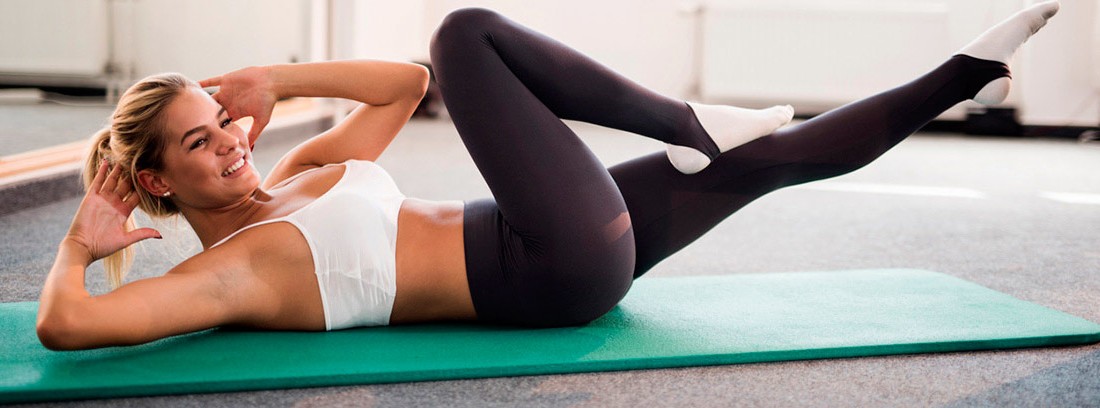Abdominal exercises to do at home

We have to understand the "CORE" as "an abdominal girdle" that gives stability to our body. The muscles that make up the Core are: previous (rectus abdominis, external obliques, internal obliques), later (multifidus, quadratus lumbar, gluteus maximus), fixatives / stabilizers (transverse, pelvic floor and gluteus maximus).
Usually we get carried away by the aesthetic factor, the so-called tablet, without being aware that the abdominal or core muscles has other functions in our body:
- Trunk stability: improve balance.
- Postural Control: helps us to have a correct posture.
- Prevent spinal injuries: minimize back pain.
- Protection of internal organs:
- Avoid stomach hernias.
- The circular disposition of the transverse one collects the viscera and in pregnant women it helps to hold the baby.
- Improve intestinal transit.
How many sit-ups should I do a day?
Although there is no exact number of repetitions or a stipulated time of work, the core has to be worked daily following some guidelines general:
- Within a training session and / or abdominals we have to perform various exercises where we directly and / or indirectly execute all the core muscles.
- In those exercises that are through repetitions, do not execute more than 25 repetitions in a row.
- In isometric exercises, hold the position for 10-15 seconds per repetition.
- Whenever you perform exercises to the right and / or left, you have to perform the same repetitions on both sides.
- Combine repetition exercises with isometric exercises or (posture maintenance).
Exercises to do at home
One of the great advantages of abdominal work is that it is not necessary material or specific installation, since we can do it with our own body and.
Repetition exercises
- Abdominal crunch: placed face up with bent legs or knee and hip flexion at 90º, bring the navel inwards previously (activate transverse), place crossed arms on the shoulders and raise the trunk until separating the scapulae from the ground. You breathe in (breathe in) before raising your torso and exhale (release air) during your torso lift.
- Crunch with legs extended: placed face up with legs extended making a hip angle of 90º. Raise the trunk, touching the tips of the feet with the hands.
- Other variants of Crunch with extended legs: raise the trunk touching the ankles on the outside right hand left ankle-left hand-right ankle alternately. You can also place arms in the shape of a cross with the palm of the hand towards the ceiling, raising the trunk and touching the ankles on the outside with both hands at the same time.
- Lateral trunk flexion: placed on the back and with the legs bent with feet resting on the floor and arms extended to the sides, I have to flex the trunk (bend the body) laterally so that with my right hand it touches my right ankle. Breathing out during the push-up and breathing in on recovery. Next, I have to return to the starting position and repeat the process with the left side. You can also do this exercise by doing the repetitions on each side or alternating right and left or doing the same exercise while standing.
- Russian twist: seated with bent legs and a straight back. Execute turns to the right and left touching the ground with the palms of the hands. We can use a kettlebell, medicine ball or weighted disc to increase its intensity. Contraindicated exercise for those with a herniated disc.
- Glute bridge: lying on your back with your knees bent and your feet flat on the floor; raise the pelvis towards the ceiling, without curving the lumbar area and execute the gluteal contraction at the highest point of the lift.
Isometric exercises (hold position)
- Front Plank: we place ourselves horizontally face down with elbows and forearms resting on the ground and we rise on the balls of the feet. We have to maintain the horizontality of the body without lowering the lumbar curvature with the abdomen contracted and the gaze diagonally to the ground.
- Other variants of the front plate: with the same position, but raising one foot and alternating left and right. It can also be done in 4 beats with the starting position placed in the same position as the front plank, but we lean on our hands with our arms extended (pay attention to shoulder, elbow and wrist alignment). Next, we descend and lean on our forearms and return to the starting position; repeating the process always with the abdomen in contraction.
- Superman: placed in quadruped (on all fours) we raise the opposite arm and leg, maintaining the position at a horizontal level, tightening the abdomen. You can also do the initial Superman position, flex your arm and leg approaching the center of the body without losing the horizontality of the body.
- Side plank: we stand on our side with legs stretched out and lean on the forearm, keeping the body horizontal. Maintain the position to the left and right at the same time. Another way to do this exercise is, with the same position, to lean on the extended arm (shoulder, elbow, wrist) or by raising the leg. (supported on forearm or arm)
- We tend to get carried away by the aesthetic factor of the rectus anterior (tablet) without being aware that the abdominal muscles (core) are involved in many other functions of the body.
- Although there is no exact number of repetitions or a stipulated time of work, the core has to work daily following some general guidelines.
- One of the great advantages of abdominal work is that no specific material or installation is needed; It is done with your own body and you do not have to go to the gym.
Jesus Angel Aguilar Luna Bachelor of Science in Physical Activity and Sports
(Updated at Apr 14 / 2024)